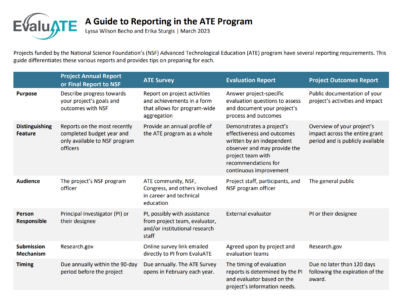
Strategies for Success
Learn tips for collecting student data in ATE from Bridgerland Technical College.
LEARN MOREPreview the 2026 ATE Survey questions in either PDF or Word format. Download the version that works best for you as you prepare for the survey.
An updated frequently asked questions page will be available in December. You can refer to last year’s FAQ sheet below.

Learn tips for collecting student data in ATE from Bridgerland Technical College.
LEARN MORE
View data collection templates from Bridgerland Technical College.
VIEW TEMPLATEExplore an example of student tracking from Rio Salado College.
VIEW TRACKING
View a data request form from improving advanced manufacturing technician education using industry partnerships.
VIEW FORMProjects funded by the NSF’s ATE program have several reporting requirements. This guide differentiates these various reports and provides tips on preparing for each.

Institutional Research (IR) offices can support you in accessing data to document project activities and outcomes. This guide answers common questions to help you work efficiently with institutional research offices.


We at EvaluATE know that the ATE Survey is not always easy for ATE projects to complete. To lighten this burden and encourage efficient and accurate data collection, we have compiled some tips and best practices from ATE PIs and project staff. Thank you to everyone who talked with us and shared your experiences with the ATE Survey.
Start thinking about the ATE Survey at the start of your ATE project and revisit the survey at least once a year. Consider these points to ensure that the necessary information is collected efficiently, accurately, and with minimal disruption.
Some data might require tracking throughout the year. Other data may be compiled right before the survey launches.
Remember these tips for when you are completing and submitting the survey.
Contact Lee McClure with any questions or concerns about the ATE Survey at
atesurvey@evalu-ate.org or (269) 387-3771.